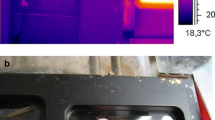Summary
Robber flies (Diptera: Asilidae) were studied in Panama from May through August. Of the 16 species examined, 5 perched and foraged in the sun and 11 perched and foraged in the shade. Thoracic body temperatures of light-seeking flies ranged from 35.2–40.6°C during foraging. Light-seeking flies regulated body temperature behaviorally by microhabitat selection and postural adjustments, and physiologically by transferring warmed haemolymph from the thorax to the cooler abdomen. Thoracic temperatures of shade-seeking flies passively followed ambient temperature in the shade and these flies did not thermoregulate. None of these robber flies warmed endothermically in the absence of flight. Resting oxygen consumption (\(\dot V_{O_2 } \)) of both groups scaled with body mass to the 0.77 power. The factorial increment in \(\dot V_{O_2 } \) resulting from hovering flight ranged from 12 to 56. The \(\dot V_{O_2 } \) increased markedly with body temperature in light-seeking flies and probably explains the greater foraging effort observed in these species. Wing loading of all 16 species of robber flies scaled with body mass to the 0.39 power. Large light-seeking flies had heavier wing loading than large shade-seeking flies. The differences in body temperature and wing loading between light-seeking and shade-seeking robber flies may be related to differences in flight speed and maneuverability during foraging.
Similar content being viewed by others
Abbreviations
- T th :
-
thoracic temperature
- T ab :
-
abdominal temperature
- T a :
-
anibient temperature
- \(\dot V_{O_2 } \) :
-
oxygen consumption
References
Bartholomew GA, Casey TM (1977) Body temperature and oxygen consumption during rest and activity in relation to body size in some tropical beetles. J Thermal Biol 2:173–176
Bartholomew GA, Casey TM (1978) Oxygen consumption of moths during rest, pre-flight warm-up, and flight in relation to body size and wing morphology. J Exp Biol 76:11–25
Chappell MA (1982) Temperature regulation of carpenter bees (Xylocopa californica) foraging in the Colorado Desert of Southern California. Physiol Zool 55:267–280
Heinrich B (1970) Thoracic temperature stabilization by blood circulation in a free-flying moth. Science 168:580–582
Heinrich B (1971) Temperature regulation of the sphinx moth,Manduca sexta. II. Regulation of heat loss by control of blood circulation. J Exp Biol 54:153–166
Heinrich B (1972) Thoracic temperature of butterflies in the field near the equator. Comp Biochem Physiol 43A:459–467
Heinrich B (1976) Heat exchange in relation to blood flow between thorax and abdomen in bumblebees. J Exp Biol 64:561–585
Heinrich B (1979) Thermoregulation of African and European honeybees during foraging, attack, and hive exits and returns. J Exp Biol 80:217–229
Heinrich B (1981) Ecological and evolutionary perspectives. In: Heinrich B (ed) Insect thermoregulation. Wiley, New York, pp 235–302
Heinrich B (1984) Strategies of thermoregulation and foraging in two vespid wasps,Dolichovespula maculata andVespula vulgaris. J Comp Physiol B 154:175–180
Heinrich B, Casey TM (1978) Heat transfer in dragonflies: “Fliers” and “perchers”. J Exp Biol 74:17–36
Heinrich B, Pantle C (1975) Thermoregulation in small flies (Syrphus sp.): Basking and shivering. J Exp Biol 62:599–610
Holdridge LR, Budowski G (1956) Report on an ecological survey on the Republic of Panama. Caribbean Forestry 17:92–110
Hull FM (1962) Robber flies of the world. The genera of the family Asilidae. US Natl Mus Bull 224 (Pts. 1&2). US Govt Printing Office 907 pp
Josephson RK (1981) Temperature and the mechanical performance of insect muscle. In: Heinrich B (ed) Insect thermoregulation. Wiley, New York, pp 20–44
Keister M, Buck J (1974) Respiration: some exogenous and endogenous effects on rate of respiration. In: Rockstein M (ed) The physiology of insecta, 2nd, vol 6. Academic Press, New York London, pp 469–509
Kittel A (1941) Körpergrösse, Körperzeiten und Energiebilanz. II. Der Sauerstoffverbaruch der Insekten in Abhängigkeit von der Körpergrösse. Z Vergl Physiol 28:533–562
Knight DH (1975) A phytosociological analysis of species-rich tropical forest on Barro Colorado Island, Panama. Ecol Monogr 45:259–284
Krogh A, Zeuthen E (1941) The mechanism of flight preparation in some insects. J Exp Biol 18:1–10
Lighthill J (1977) Introduction to the scaling of aerial locomotion. In: Pedley TJ (ed) Scaie effects in animal locomotion. Academic Press, London, pp 365–404
Machin KE, Pringle JWS, Tamasige M (1962) The physiology of insect fibrillar muscle. IV. The effect of temperature on a beetle flight muscle. Proc R Soc B 155:493–499
May ML (1978) Thermal adaptation of dragonflies. Odonatologica 7:27–47
May ML (1979) Energy metabolism of dragonflies (Odonata: Anisoptera) at rest and during endothermic warm-up. J Exp Biol 83:79–94
Papavero N (1973) Studies of Asilidae (Diptera) systematics and evolution. I. A preliminary classification of subfamilies. Arq Zool, S Paulo 23:217–274
Scholander PF (1947) Analyzer for accurate estimation of respiratory gases in one-half cubic centimeter samples. J Biol Chem 167:235–250
Shelly TE (1982) Comparative foraging behavior of light versus shade-seeking adult damselflies in a lowland neotropical forest (Odonata: Zygoptera). Physiol Zool 55:335–343
Shelly TE (1984) Comparative foraging behavior of neotropical robber flies (Diptera: Asilidae). Oecologia 62:188–195
Shelly TE (1985) Niche relationships of robber fly species (Diptera: Asilidae) in a Neotropical forest. Oecologia (in press)
Willmer PG (1982) Thermoregulatory mechanisms inSarcophaga. Oecologia 53:382–385
Author information
Authors and Affiliations
Rights and permissions
About this article
Cite this article
Morgan, K.R., Shelly, T.E. & Kimsey, L.S. Body temperature regulation, energy metabolism, and foraging in light-seeking and shade-seeking robber flies. J Comp Physiol B 155, 561–570 (1985). https://doi.org/10.1007/BF00694445
Accepted:
Issue Date:
DOI: https://doi.org/10.1007/BF00694445




